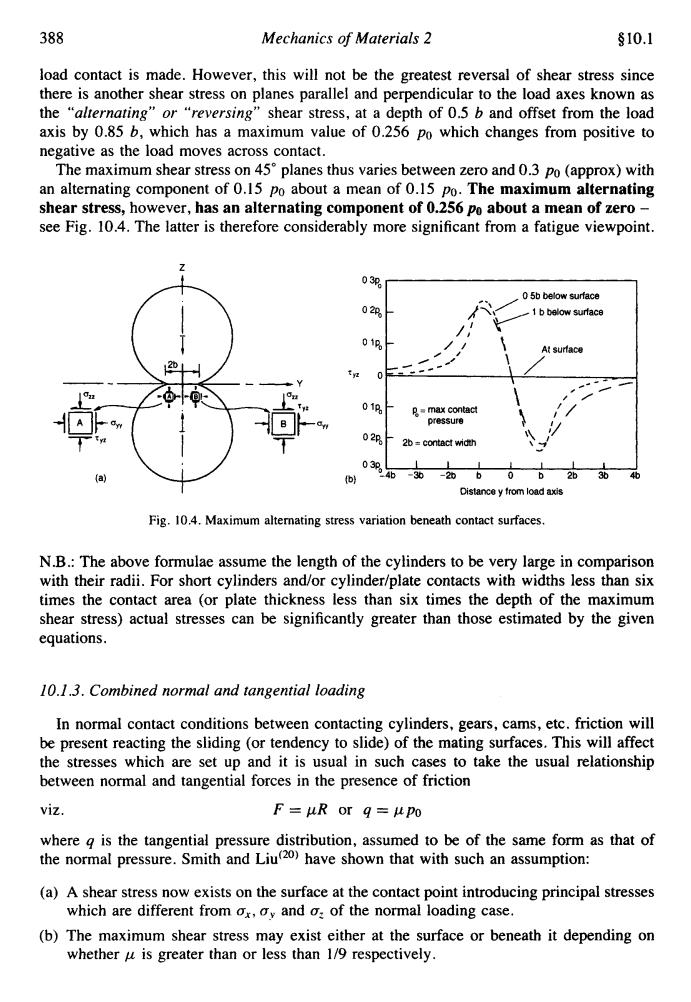正在加载图片...

388 Mechanics of Materials 2 §10.1 load contact is made.However,this will not be the greatest reversal of shear stress since there is another shear stress on planes parallel and perpendicular to the load axes known as the "alternating"or "reversing"shear stress,at a depth of 0.5 b and offset from the load axis by 0.85 b,which has a maximum value of 0.256 po which changes from positive to negative as the load moves across contact. The maximum shear stress on 45planes thus varies between zero and 0.3 po (approx)with an alternating component of 0.15 po about a mean of 0.15 Po.The maximum alternating shear stress,however,has an alternating component of 0.256 Po about a mean of zero- see Fig.10.4.The latter is therefore considerably more significant from a fatigue viewpoint. 03p 05b below surface 020 1 b below surface At surface 01p 具=max contact pressure 02 26=contac时wMdh 03p b 46-36-26062b36 46 Distancey from load axis Fig.10.4.Maximum alternating stress variation beneath contact surfaces. N.B.:The above formulae assume the length of the cylinders to be very large in comparison with their radii.For short cylinders and/or cylinder/plate contacts with widths less than six times the contact area (or plate thickness less than six times the depth of the maximum shear stress)actual stresses can be significantly greater than those estimated by the given equations. 10.1.3.Combined normal and tangential loading In normal contact conditions between contacting cylinders,gears,cams,etc.friction will be present reacting the sliding (or tendency to slide)of the mating surfaces.This will affect the stresses which are set up and it is usual in such cases to take the usual relationship between normal and tangential forces in the presence of friction viZ. F=uR or g=upo where g is the tangential pressure distribution,assumed to be of the same form as that of the normal pressure.Smith and Liu20)have shown that with such an assumption: (a)A shear stress now exists on the surface at the contact point introducing principal stresses which are different from ox,oy and o:of the normal loading case. (b)The maximum shear stress may exist either at the surface or beneath it depending on whether u is greater than or less than 1/9 respectively.388 Mechanics oj Materials 2 $10.1 load contact is made. However, this will not be the greatest reversal of shear stress since there is another shear stress on planes parallel and perpendicular to the load axes known as the “alrernating” or “reversing” shear stress, at a depth of 0.5 b and offset from the load axis by 0.85 b, which has a maximum value of 0.256 po which changes from positive to negative as the load moves across contact. The maximum shear stress on 45” planes thus varies between zero and 0.3 po (approx) with an alternating component of 0.15 po about a mean of 0.15 PO. The maximum alternating shear stress, however, has an alternating component of 0.256 po about a mean of zero - see Fig. 10.4. The latter is therefore considerably more significant from a fatigue viewpoint. I Distance y from load axis Fig. 10.4. Maximum alternating stress variation beneath contact surfaces. N.B.: The above formulae assume the length of the cylinders to be very large in comparison with their radii. For short cylinders and/or cylindedplate contacts with widths less than six times the contact area (or plate thickness less than six times the depth of the maximum shear stress) actual stresses can be significantly greater than those estimated by the given equations. 10.1.3. Combined normal and tangential loading In normal contact conditions between contacting cylinders, gears, cams, etc. friction will be present reacting the sliding (or tendency to slide) of the mating surfaces. This will affect the stresses which are set up and it is usual in such cases to take the usual relationship between normal and tangential forces in the presence of friction viz. F=pR or q=ppo where q is the tangential pressure distribution, assumed to be of the same form as that of the normal pressure. Smith and Lid2’) have shown that with such an assumption: (a) A shear stress now exists on the surface at the contact point introducing principal stresses (b) The maximum shear stress may exist either at the surface or beneath it depending on which are different from a,, uy and uz of the normal loading case. whether p is greater than or less than 1/9 respectively